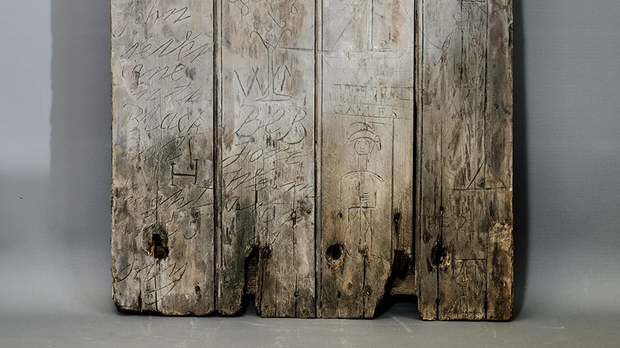A recently discovered wooden door on the top floor of a French Revolution-era watchtower offers an intimate look into the lives of British soldiers who spent hours stationed there during the war, experts say. The door is covered in carved inscriptions and illustrations that seem to reflect the soldiers’ daily experiences and, for the most part, do not paint a happy picture.
Among several notable dates and ostentatious surnames carved into the wood are some mysterious drawings, in which stick-like people are being hanged. One of these drawings may even represent the hanging of Napoleon Bonaparte, the French emperor and military commander whose threats to invade the United Kingdom in the late 18th century forced a massive British military mobilization.
These defensive preparations in England turned out to be unnecessary because the French invasion never actually took place, and Napoleon was not hanged in the end but died in poor health in exile on the remote island of Saint Helena in 1821. Some controversy and debate over what exactly caused its decline and death still exists today.
English Heritage
But, before Napoleon’s exile, and in the midst of successful military campaigns during the French Revolution, England in the 1790s began to bolster its own resources in the event of a possible attack. That’s when Dover Castle, a medieval fortress in Kent along the English Channel, was repurposed as a military garrison that housed thousands of soldiers, according to English Heritage, a British charity that helps manage the country’s historic sites and monuments. Paul Pattison, the charity’s senior property historian, was the one who found the wooden door at the top of St John’s Tower in the grounds of Dover Castle.
“Climbing a staircase to the top floor of St. John’s Tower and seeing these remarkable carvings on the door was an amazing discovery. This graffiti gives a unique insight into the minds of these soldiers, especially during such a fraught period of time,” said Pattison . in a statement.
Calling the door “an extraordinary object,” Pattison added that “it is a rare and precious example of an ordinary person making their mark; whether simply for the purpose of killing time or wanting to be remembered.”
Between six and 12 soldiers stood guard 24 hours a day at St John’s Tower, in the outer moat surrounding the castle, with one or two soldiers stationed at the top of the tower, English Heritage said. The organization suggested that these men may have “put their questionable artistic talents to use” to kill time during their shifts, using knives or bayonets.
English Heritage
More than 50 graffiti were engraved on the door, including three notable dates: 1789, the year the French Revolution began; 1798, when Dover Castle was being rebuilt; and 1855, when changes to São João Tower were being planned.
English Heritage said the door also contains several sets of initials and two surnames, a detailed carving of a single-masted sailing ship used by the Royal Navy, a potentially religious symbol of a wine cup or goblet with an “elaborate cross”. and “at least nine gruesome illustrations of hangings”. Royal hangings took place in Dover and at that time were a form of public entertainment. But experts have suggested that one of those illustrations of a man wearing a military uniform and bicornuate or two-cornered hat it could have been created to represent the French military leader whose war plans caused such unrest for the soldiers at Dover Castle.
The door was removed from St John’s Tower and underwent conservation procedures ahead of its planned display at Dover Castle, now a museum, in July. It will form part of an exhibition called “Dover Castle under siege”, English Heritage said.























